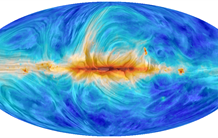
Miville-Deschênes/CNRS
The Planck collaboration, which notably involves the CNRS, the CEA, the CNES and several French universities and institutions, reveals data from the four years of observation of the European Space Agency's (ESA) Planck satellite. The Planck mission is dedicated to the study of fossil radiation, the luminous echo of the Big-Bang. The measurements, made in nine frequency bands, make it possible to construct maps of the temperature of the sky but also of its polarization, which gives us additional information both on the very young Universe (380 000 years old) and on the magnetic field of our Galaxy. These data and associated articles are submitted to the journal Astronomy & Astrophysics and are available on the ESA website. Information that will help to better determine the matter and energy content of the Universe, the time of birth of the first stars and the current rate of expansion of space.
Click here to read the press release in French on the CEA website

